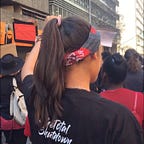What is climate justice?
Climate justice does not mean reaching net zero emissions by 2050; it is about racial justice, gender equality and dismantling oppressive systems.
In 2020, massive locust swarms harmed crops in Africa, wildfires raged across the US and Australia, and India and Bangladesh were hit with intense cyclones. Unsurprisingly, the most impacted in these countries were the poorest and most marginalised communities. According to Oxfam, the world’s richest 1% emit more than double the amount of carbon dioxide compared to the poorest 50%. While they contribute the least to climate change, the poorest countries are the most impacted (by both extreme weather events and slow onset disasters).
Women, particularly in low income countries, are disproportionately impacted. Violence against women soars when natural disasters occur. 80% of climate refugees are women, while they make up only 30% of national and international climate negotiating groups. In many rural villages, women and girls are meant to fetch the water, provide food and take care of people when they get sick. As a result, they face the brunt of climate change.
Racial disparity and climate injustice are completely linked. Let’s take a look at the US, for example. A paper by the Joint Center for Political and Economic Studies revealed that over 30% of Black residents in New Orleans did not possess cars when Hurricane Katrina hit. This meant it was not possible for them to flee. Another US-based study in the Proceedings of the National Academies of Sciences discovered that Hispanic and Black communities are subject to a significant amount more air pollution than they contribute to. Inversely, white residents are exposed to far better air quality, when they are responsible for more emissions. Districts that were redlined and primarily POC-populated tend to have less trees, higher average temperatures, and more sidewalks, which can cause fatal heat sicknesses. Additionally, coastal areas in the American South that have large Black populations are the most at risk from rising sea levels.
Even though POC and women are being hit the hardest, they are a main part of the solution. Women are leading the fight for climate justice across the globe. A minimum of 2x more Black and Hispanic teenagers walked out of school for climate protests than white teenagers in the US, according to a Washington Post-Kaiser Family Foundation Poll (2019). Climate activism in the media tends to be centred around white people, but this is not the case in real life.
Namibia is a Southern African country that is heavily reliant on the primary sector, which means it is greatly impacted by climate change. Deon Shekuza co-founded the Namibian Youth on Renewable Energy, which is an NGO set on mainstreaming young people into the energy sector and decision-making positions. Activists like Shekuza have the aim of bringing climate science discussions nation-wide and linking it to local socio-economic aspects.
Madhu Krishnan, professor at the University of Bristol, said, “if you look globally at what happened to climate, a disproportionate amount of blame does need to go to the global north, especially the former colonial powers. Environmental reparations are owed, and more thought needs to be given to solutions. The idea of carbon offsets simply reinscribes colonial frameworks.”
System change is essential for combating climate change and achieving climate justice. Environmental justice cannot be achieved without racial justice. We must invest in marginalised communities and pressure policymakers and wealthy countries to support this systemic change.
